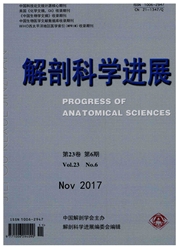

 中文摘要:
中文摘要:
目的探讨5-羟基-1-甲基海因(HMH)对百草枯所致大鼠肾损伤的保护作用及其可能机制。方法将24只雄性SD大鼠按随机数字表法分为对照组、百草枯组、维生素C组、HMH组4组,每组6只。对照组腹腔注射无菌生理盐水2 mg/kg;百草枯组腹腔注射等体积稀释的百草枯溶液50 mg/kg;维生素C组和HMH组腹腔注射百草枯溶液的同时分别灌胃维生素C或HMH溶液1 mmol/kg。应用Fenton法测定HMH和维生素C清除羟自由基的能力。各组分别于染毒后24 h采血并处死动物取肾组织,测定血清尿素氮(BUN)、血肌酐(SCr)及肾皮质蛋白、丙二醛(MDA)、还原型谷胱甘肽(GSH)含量和超氧化物歧化酶(SOD)活性。结果维生素C和HMH均有很好的清除羟自由基的能力,50%抑制浓度(IC50值)均为4.02 mg/mL。与对照组比较,百草枯组血清BUN、SCr及肾组织MDA含量显著升高,肾组织蛋白、GSH含量及SOD活性显著下降〔BUN(mmol/L):40.80±2.49比13.67±1.58, SCr(μmol/L):163.46±8.67比51.80±4.37, MDA(nmol/g):7.51±0.23比4.52±0.33,蛋白(μmol/L):0.94±0.14比1.35±0.10, GSH(mg/g):1.08±0.48比3.30±0.44, SOD(kU/L):70.74±6.42比112.89±8.72,均P<0.01〕。与百草枯组比较,维生素C组和HMH组血清BUN、SCr及肾组织MDA显著下降,肾组织GSH含量和SOD活性显著升高〔BUN(mmol/L):22.64±2.36、18.71±5.23比40.80±2.49, SCr(μmol/L):97.28±4.81、89.20±6.72比163.46±8.67, MDA(nmol/g):4.67±0.31、4.21±0.42比7.51±0.23,GSH(mg/g):1.78±0.10、1.86±0.39比1.08±0.48,SOD(kU/L):98.69±5.43、103.76±4.45比70.74±6.42,均P<0.01〕;HMH组较维生素C组可显著降低SCr含量(P<0.05),而两组在血BUN及肾组织MDA、GSH含量和SOD活性方面差异无统计学意义(均P>0.05)。结论 HMH能防护百草枯所致的大鼠肾损伤,其机制可能与其抗氧化和清除羟自由基的作用有密切
 英文摘要:
英文摘要:
ObjectiveTo investigate the protective effects of 5-hydroxy-1-methylhyantoin (HMH) on paraquat (PQ)-induced nephrotoxicity in rat and its possible mechanism.Methods Twenty-four male Sprague-Dawley (SD) rats were randomly divided into four groups: namely control, PQ, vitamin C and HMH groups, with 6 rats in each group. The rats in control group were given an injection of 2 mg/kg of normal saline intraperitoneally. The rats in PQ group were given an injection of 50 mg/kg of PQ intraperitoneally. The rats in vitamin C and HMH groups were given 1 mmol/kg of vitamin C or HMH through gastric tube right after PQ injection. The hydroxyl free radical scavenging ability of HMH and vitamin C was determined by Fenton method. Blood sample was collected after 24 hours of PQ treatment, then the animals were sacrificed and renal tissues were harvested. Blood urea nitrogen (BUN), serum creatinine (SCr), protein content of renal cortex, blood malondialdehyde (MDA), reduced glutathione (GSH) and superoxide dismutase (SOD) activity were determined.Results Both vitamin C and HMH showed a very good ability to scavenge hydroxyl radicals, and the 50% inhibiting concentration (IC50) was both 4.02 mg/mL. Compared with control group, serum BUN, SCr and MDA in renal tissue were significantly increased in PQ group, and the protein, GSH contents and SOD activity were significantly decreased [BUN (mmol/L): 40.80±2.49 vs. 13.67±1.58, SCr (μmol/L): 163.46±8.67 vs. 51.80±4.37, MDA (nmol/g): 7.51±0.23 vs. 4.52±0.33, protein (μmol/L): 0.94±0.14vs. 1.35±0.10, GSH (mg/g): 1.08±0.48 vs. 3.30±0.44, SOD (kU/L): 70.74±6.42 vs. 112.89±8.72, allP〈 0.01]. Compared with PQ group, serum BUN and SCr and MDA in kidney tissue in vitamin C and HMH groups were significantly decreased, and GSH content and SOD activity in kidney tissue were significantly elevated [BUN (mmol/L):22.64±2.36, 18.71±5.23 vs. 40.80±2.49, SCr (μmol/L): 97.28±4.81, 89.20±6.72 vs. 163.
 同期刊论文项目
同期刊论文项目
 同项目期刊论文
同项目期刊论文
 Low-dose Endothelial Monocyte-activating Polypeptide-II Increases Permeability of Blood-tumor Barrie
Low-dose Endothelial Monocyte-activating Polypeptide-II Increases Permeability of Blood-tumor Barrie Overexpression of Roundabout4 predicts poor prognosis of primary glioma patients via correlating wit
Overexpression of Roundabout4 predicts poor prognosis of primary glioma patients via correlating wit MiR-18aincreased the permeability of BTB via RUNX1 mediated down-regulation of ZO-1, occluding and c
MiR-18aincreased the permeability of BTB via RUNX1 mediated down-regulation of ZO-1, occluding and c C-terminus of Human BKca Channel Alpha Subunit Enhances the Permeability of the Brain Endothelial Ce
C-terminus of Human BKca Channel Alpha Subunit Enhances the Permeability of the Brain Endothelial Ce MiR-330-Mediated Regulation of SH3GL2 Expression Enhances Malignant Behaviors of Glioblastoma Stem C
MiR-330-Mediated Regulation of SH3GL2 Expression Enhances Malignant Behaviors of Glioblastoma Stem C Functions for the cAMP/Epac/Rap1 Signaling Pathway in Low-Dose Endothelial Monocyte-Activating Polyp
Functions for the cAMP/Epac/Rap1 Signaling Pathway in Low-Dose Endothelial Monocyte-Activating Polyp Signal Mechanisms Underlying Low-Dose Endothelial Monocyte-Activating Polypeptide-II-Induced Opening
Signal Mechanisms Underlying Low-Dose Endothelial Monocyte-Activating Polypeptide-II-Induced Opening Roundabout 4 regulates blood-tumor barrier permeability through the modulation of ZO-1, Occludin, an
Roundabout 4 regulates blood-tumor barrier permeability through the modulation of ZO-1, Occludin, an Roles of Serine/Threonine Phosphatases in Low-Dose Endothelial Monocyte-Activating Polypeptide-II-In
Roles of Serine/Threonine Phosphatases in Low-Dose Endothelial Monocyte-Activating Polypeptide-II-In Low-Dose Endothelial Monocyte-Activating Polypeptide-II Increases Blood-Tumor Barrier Permeability b
Low-Dose Endothelial Monocyte-Activating Polypeptide-II Increases Blood-Tumor Barrier Permeability b Role of cAMP-dependent protein kinase A activity in low-dose endothelial monocyte-activating polypep
Role of cAMP-dependent protein kinase A activity in low-dose endothelial monocyte-activating polypep MiR-152 functions as a tumor suppressor in glioblastoma stem cellsby targeting Krüppel-like factor 4
MiR-152 functions as a tumor suppressor in glioblastoma stem cellsby targeting Krüppel-like factor 4 miR-34c Regulates the Permeability of Blood-Tumor Barrier via MAZ-Mediated Expression Changes of ZO-
miR-34c Regulates the Permeability of Blood-Tumor Barrier via MAZ-Mediated Expression Changes of ZO- Roundabout4 suppresses glioma-induced endothelial cell proliferation, migration and tube formation i
Roundabout4 suppresses glioma-induced endothelial cell proliferation, migration and tube formation i Endothelial-monocyte-activating polypeptide II induces rat C6 glioma cell apoptosis via the mitochon
Endothelial-monocyte-activating polypeptide II induces rat C6 glioma cell apoptosis via the mitochon Low-dose endothelial monocyte-activating polypeptide-II increases permeability of blood–tumor barrie
Low-dose endothelial monocyte-activating polypeptide-II increases permeability of blood–tumor barrie Knockdown of long non-coding RNA HOTAIR inhibits malignant biological behaviors of human glioma cell
Knockdown of long non-coding RNA HOTAIR inhibits malignant biological behaviors of human glioma cell CRNDE affects the malignant biological characteristics of human glioma stem cells by negatively regu
CRNDE affects the malignant biological characteristics of human glioma stem cells by negatively regu Prognostic significance of osteopontin and carbonic anhydrase 9 in human brain tumors: A Meta-Analys
Prognostic significance of osteopontin and carbonic anhydrase 9 in human brain tumors: A Meta-Analys MiR-449a exerts tumor-suppressive functions in human glioblastoma by targeting Myc-associated zinc-f
MiR-449a exerts tumor-suppressive functions in human glioblastoma by targeting Myc-associated zinc-f CRM197 in combination with shRNA interference of VCAM-1 displays enhanced inhibitory effects on huma
CRM197 in combination with shRNA interference of VCAM-1 displays enhanced inhibitory effects on huma 期刊信息
期刊信息
